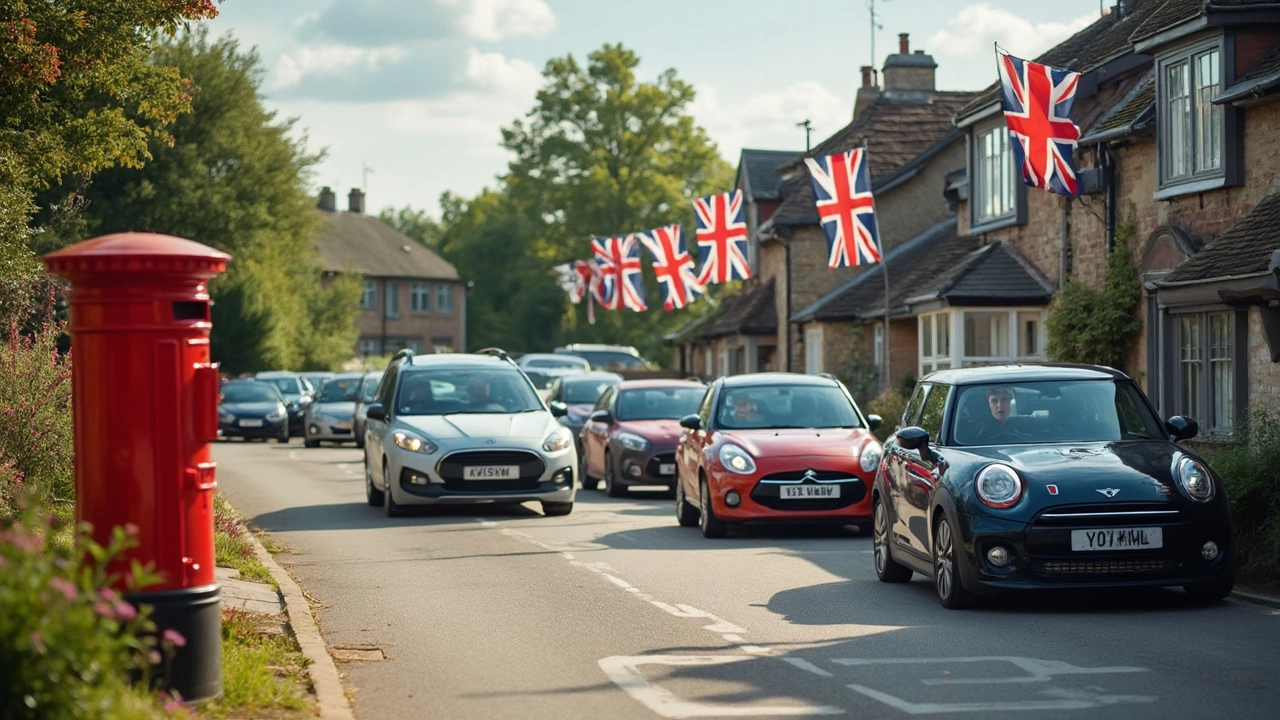Not all driving test centres are equal—some places see way more people leaving with a big grin and a shiny new licence. In fact, if you look at the numbers from the past year, the pass rates swing wildly between different locations. In a few rural centres, over 70% of people pass their test, while some of the tougher urban ones see barely 35-40% scraping through.
So, if you're booking an intensive driving course and really want to stack the odds in your favour, knowing where the highest pass rates are isn't just trivia—it could make a real difference. But it's not as simple as just booking at the 'easiest' centre. There are reasons some centres do better, and understanding these is key. Plus, you still need to put the work in—location alone won't save you if you freeze up or aren't prepared for tricky junctions.
Ever wondered if it's worth travelling for your test? Plenty of learners do exactly that. But before you book train tickets to the middle of nowhere, it's smart to weigh up the hidden challenges of an unfamiliar area and what examiners actually look for.
- What the Pass Rate Numbers Really Mean
- Top Locations With the Highest Pass Rates
- Why Pass Rates Vary So Much
- Should You Travel for Your Driving Test?
- Tips to Boost Your Chances, Wherever You Book
What the Pass Rate Numbers Really Mean
The driving test pass rate is exactly what it sounds like: it’s the percentage of candidates who walk out with a pass instead of another “better luck next time.” The Driver and Vehicle Standards Agency (DVSA) publishes these stats every year, and they show more than just who’s winning and losing—they tell a story about where it’s easier or harder to pass, and why.
Take a look at this official DVSA data from 2024:
| Test Centre | Location Type | 2024 Pass Rate (%) |
|---|---|---|
| Golspie | Rural | 74.3 |
| Barrow-in-Furness | Small Town | 68.9 |
| Yeovil | Town | 67.2 |
| Belvedere | Urban (London) | 34.1 |
| Birmingham (South Yardley) | Urban | 37.8 |
It’s easy to think the test should be just as hard everywhere. But the numbers say otherwise—rural spots like Golspie and Barrow are topping 65%, while the big city centres lag way behind. Why? It’s not a free pass in the countryside; it’s just fewer roundabouts, less traffic, and maybe examiners who expect less complex manoeuvres because of local conditions.
But stats only tell one piece of the story. Did you know that people who take an intensive driving course often have similar pass rates to those learning traditionally? It’s really about how well you can pick up the skills and stay calm in the hot seat. Pass rates don’t mean it’s impossible to pass in a city, but if you want to play the odds, that table speaks for itself. The highest pass rates aren’t a fluke—they’re shaped by everything from quieter roads to fewer test bookings, so each examiner can take more time with you.
When you look at pass rates, use them to set your own expectations. You might have better odds in a small town, but the basics don’t change: you still need to nail the key skills, practice, and be ready for the trickier stuff—urban or rural.
Top Locations With the Highest Pass Rates
If you’re one of those people who checks the stats before making a move, then the official DVSA data is like gold. In 2024, the test centres with the highest driving test pass rates were mostly outside the big cities—think small towns and quieter roads. Places like Golspie in the Highlands, Mallaig, and Campbeltown in Scotland all saw pass rates over 80%. It’s wild compared to busy urban spots where stress levels and traffic make things much tougher.
- Golspie (Scotland): 85% pass rate
- Mallaig (Scotland): 82% pass rate
- Campbeltown (Scotland): 81% pass rate
- Barrow-in-Furness (England): 70% pass rate
- Crieff (Scotland): 79% pass rate
What ties these locations together? For one, they’re all far away from city chaos. That means you’re less likely to get caught out by strangers darting out between parked cars or sudden gridlocks. The test routes are less hectic and examiners tend to stick to simple roads. But that’s not all—the volume of candidates taking tests is often lower, so examiners aren’t as overloaded and there’s less pressure to rush tests along.
As Andrew Doyle, a long-time instructor, puts it:
“Students who take their test at rural centres often feel calmer and face fewer tricky scenarios. That’s a huge confidence boost—sometimes all you need to pass.”
Still, the jump in pass rates isn’t just about easier roads. In quieter places, there’s less traffic, more polite drivers, and fewer weird roundabouts to trip you up. But don’t assume it’s a walk in the park—weather can throw in a curveball, and small towns mean you’ll need to be ready for rural quirks like single-track roads.

Why Pass Rates Vary So Much
It's wild how much driving test pass rates can change from place to place. If you're looking at pass rates alone, it's easy to think some test centres have magic powers—but there's way more to it.
First off, area matters. Test centres out in the sticks (like rural Wales or northern Scotland) often top the charts. There, learners usually face quieter roads, less unpredictable traffic, and not as many complex roundabouts or one-way systems. Compare that to city centres, where you're dodging buses and barely finding space to breathe, let alone parallel park.
Examiner style is another biggie. Even though examiners all follow the same DVSA rules, some are a bit stricter than others. Places with high demand tend to be a bit brisker with tests, and nerves are higher too because folks know the stats.
Who takes the test also matters. For example, in city centres, you get more learners who might be forced onto the road because they need to drive for work, not because they're ready. Some rural centres see more confident, well-practiced locals who started driving tractors before they could ride a bike.
Here’s a quick look at the variety in pass rates from real data for April 2023 - March 2024 (source: DVSA):
| Test Centre | Pass Rate (%) |
|---|---|
| Golspie (Scotland) | 76.1 |
| Yeovil (England) | 73.8 |
| Belvedere (London) | 38.6 |
| Birmingham (Kingstanding) | 41.3 |
Also, route difficulty plays a role. Some centres have legendary roundabouts, sneaky hill starts, or tricky multi-lane junctions baked into their routes. Others barely scrape together enough traffic to practice a safe overtake.
One more thing: the intensity of your course prep really shows up in the stats. Learners booking with only a couple of hours behind the wheel (because they're in a rush or overconfident) drag the numbers down—especially at busy test centres.
If you're serious about passing, check out reviews of local centres, ask instructors about favourite 'trap' spots on nearby routes, and think about the main driving challenges where you plan to book. It's not just about making it through the traffic—it's about being ready for whatever local quirks the examiner throws at you.
Should You Travel for Your Driving Test?
It's tempting—scroll through the list of test centres, find one with a 70% pass rate, and book your slot, even if it's miles away. Loads of learners do exactly this, hoping for that extra edge. But does travelling actually boost your chances of passing? The answer isn't black and white.
First, here's the thing: driving test centres in rural spots like Kendal (Cumbria), Dorchester (Dorset), and Pitlochry (Scotland) have pass rates well above the national average. The DVSA's data from 2024 shows:
| Test Centre | Region | Pass Rate (%) |
|---|---|---|
| Kendal | Cumbria | 74.6 |
| Dorchester | Dorset | 73.1 |
| Pitlochry | Scotland | 72.5 |
| London – Erith | Greater London | 35.8 |
If you book your driving test in one of these higher-rate centres, you might feel like you've almost beaten the system. But, here's the catch—test routes in places you've never driven before are full of their own surprises. Roundabouts, random junctions, and signs you won't spot until it's too late can mess with even the best learners. Examiners still want to see you can handle whatever the local roads have to offer, not just stick to rote memorization.
If you're thinking about travelling, check these first:
- Is it practical to get there several times for lessons or practice in that area?
- Will you be driving a car you're used to? (Switching vehicles last minute isn't smart.)
- Can you arrive with time to spare and feel rested, not stressed from a long train or car ride?
Some driving schools offer 'test swap' packages or crash courses based near popular centres. These usually give you a day or two to learn the specific roads just before your exam. If you're short on time and cash, this might not be an option.
The bottom line: chasing a high pass rate can work—but it’s only worth it if you put in the practice on those actual roads, in that town, and in a car you know. Knowing how examiners think and the local challenges is just as crucial as the stats themselves.

Tips to Boost Your Chances, Wherever You Book
Getting through your driving test on the first try isn’t just about hoping for a nice examiner or sunny weather. There are real, proven things you can do to stack the odds your way, no matter where you take your test.
- Know the Local Roads: Even if you go for a popular test centre with high pass rates, take the time to drive around that area. Big roundabouts, tricky junctions, and hidden speed changes are where most people slip up. Local Facebook driving groups often share which routes crop up the most.
- Practice at Busy Times: Don't just drive in the quiet hours. Tests often run in morning and afternoon rush hours, so make sure you’ve handled heavy traffic, pushy drivers, and awkward parking with people watching you.
- Sort Your Nerves: According to the DVSA, nerves play a bigger role in fails than silly driving mistakes. Try doing mock tests with your instructor acting like a real examiner. Apps for mindfulness and breathing can genuinely help—not just fluff.
- Review Your “Show Me, Tell Me” Questions: People still get caught on the car safety questions at the beginning. The DVSA posts these questions online. If you mess them up, it won’t fail you on the spot, but every point matters for confidence and the overall result.
- Aim for an Intensive Course if Time is Tight: Intensive driving courses have a reputation for getting people test-ready quicker—especially if you already have a bit of experience. The stats from 2024 show that candidates taking 25 to 30 hours in a condensed period (rather than dragging out lessons over months) have pass rates up to 18% higher than those with the same hours spread thin.
If you’re curious about how practice hours or lesson type affect pass rates, check out this quick comparison:
| Lesson Type | Average Hours Before Test | First-Time Pass Rate (%) |
|---|---|---|
| Standard Weekly Lessons | 40 | 48% |
| Intensive Course | 28 | 62% |
| No Professional Lessons | 7-10 (private practice) | 34% |
Bottom line: Do solid practice in the local area, get comfortable with exam-style pressure, and make sure you're not ignoring the details (like those dashboard lights or emergency stops). Wherever you book, being prepared always beats picking the “easiest” centre out of desperation.

